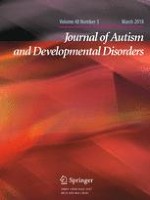27-12-2017 | Original Paper
Psychometric Properties of the Spanish Version of the Broad Autism Phenotype Questionnaire: Strengths, Weaknesses, and Future Improvements
Gepubliceerd in: Journal of Autism and Developmental Disorders | Uitgave 3/2018
Log in om toegang te krijgenAbstract
The Broad autism phenotype (BAP) refers to a set of subclinical behavioural characteristics qualitatively similar to those presented in Autism spectrum disorders (ASDs). The BAP questionnaire (BAPQ) has been widely used to assess the BAP both in relatives of ASD people and within the general population. The current study presents the first Spanish version of the BAPQ (BAPQ-SP) and analyses its psychometric properties, including validity evidences based on the BAPQ scores relationship with other variables. Our results only support the use of the Aloof and Rigid sub-scales to assess this phenotype, whereas Pragmatic Language sub-scale seems to be the main source of misfit. This research represents a first step in the study of the BAP features in the Spanish population.
